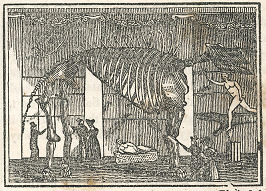Peale’s mastodon, from
The Child’s Own Book of American Geography
by
Samuel Goodrich (1832)
Charles Willson Peale founded his museum in Philadelphia, Pennsylvania, in
1786. It contained an eclectic collection of natural history specimens,
portraits of admirable historical figures, and human artifacts from various
countries—all intended to edify visitors and to show the place of human
beings as part of the animal kingdom.
His most famous display, however, was the mastodon skeleton he obtained in
1801. Eleven feet high at the shoulder and fifteen feet from chin to rump,
it was huge and strange and confusing: was it
carnivorous?
Was it an elephant? If so, what were elephants doing in North America?
There were a lot of questions to be answered about the “Great American
Incognitum.”
So it’s no wonder that when
Samuel Griswold Goodrich
described Philadelphia in The Child’s Own Book of American Geography
(also titled
The Child’s Book of American
Geography), he
included a brief description of the museum and a picture of the mastodon
skeleton on display. In his quest to provide entertaining and educational
books for children,
he quickly realized that those books needed to be illustrated. This was
especially important when describing something like the mastodon, so bizarre
that young readers would have difficulty visualizing it.
Other
writers
had included mammoths or mastodons in their works, but Goodrich managed to
show what they looked like.
Well, sort of. The image is tiny (two inches wide and 1.5 inches tall) and
the skeleton is almost lost in the background. It’s tuskless, and, to the
modern reader, the head is oddly misshapen. But the illustration certainly
gets across its point: the skeleton is huge—the human visitors barely reach
the first leg joint—and it’s evidently part of a wide-ranging collection.
What appears to be a stuffed alligator (or crocodile) is suspended in the
background, with two statues (a message-bearing Hermes and a Roman sarcophagus)
nearby. The “windows” in the back may be the display of taxidermied
birds in a self-portrait Peale painted of himself standing in his museum. Was the
illustration wholly accurate? Probably not. But it’s a charming visualization of
the major themes of Peale’s museum: education and variety.
Illustrators need models to work from, and those illustrating
early works on fossils were no
different. The skeleton pictured here greatly resembles
one drawn by Titian Ramsay
Peale II, which appeared in American Natural History, by John D.
Godman (1826-1828).
Strange as the skeleton looks, the illustration is fairly accurate. The
head is flat on the top because the top of the skull hadn’t yet been
discovered. But where are the tusks? Tusks seem to have confused
naturalists of the time; there were arguments that the tusks curved up, like
those on elephants, and there were arguments that the tusks curved down, so
the mastodon could dig for mussels (and a wood engraving by Alexander
Anderson appears to have the tusks inserted in the eye sockets). Leaving off
the tusks may have seemed the safest option.
Illustrations were expensive to produce, and publishers made sure to
get their money’s worth by reusing the
engraving blocks. Goodrich was no different: this little wood block
found its way into a more detailed description of Peale’s Museum in
The Child’s First Book of History
(1831) and—thanks to some creativity—in
Peter Parley’s Tales about the State and City
of New York (1832).
The Geography was intended to act as an introduction to the subject,
for very young children. Thus Goodrich chose to emphasize the object in
Peale’s museum for which he had an illustration—or, maybe he just knew
that very young readers would find it interesting. Though the book was
originally published in 1831, my copy is of the 1832 edition.
(Dimensions of the skeleton are in Stanley Hedeen’s Big Bone
Lick: The Cradle of American Paleontology [Lexington, KY: The
University Press of Kentucky, 2008], p. 85. Information about research on
the mastodon and the tusk controversy appears in Paul Semonin’s American
Monster: How the Nation’s First Prehistoric Creature Became a Symbol of
National Identity [New York: New York University Press, 2000].)
http://www.merrycoz.org/books/Goodrich/PPOwn/PEALE.xhtml
Peale’s mastodon, from The Child’s Own Book of American Geography, by Samuel Griswold Goodrich (Boston: Waitt & Dow, 1832; p. 35)
6. There is an Arcade at Philadelphia, where Mr. Peale’s
museum is kept. This is a collection of stuffed birds and beasts, and other
strange things; among the rest, are the bones of a huge animal, called a
Mastodon, that lived many hundred years ago. No such animals are living
now.
